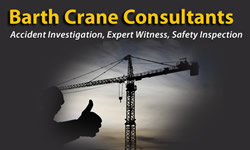articles
Crane Training Lacking In U.S.: Other Countries Lead the Way to Safety
As originally published by Craneworks, June 2005.
By: Thomas Barth
Tel: 843-871-8877
Email Mr. Barth
View Profile on Experts.com.
Here in the United States our crane training program is falling through the cracks. Other countries, such as Canada, have one of the best training programs in the world. The United States tried to put a program together by copying their program but unfortunately they left out the most valuable parts.
Crane accident statistics are limited because typically only deaths and injuries are reported. Accidents are not required to be reported unless there is one death and five hospitalizations. The seriousness of crane accidents is self-evident.
By their own admission for proposed rule making, OSHA investigated 900 crane accidents, 400 of these in the construction industry or general industry.
Other countries have initiated programs or policies for the operation of cranes that require the upgrading and certifications of skills and have lowered their accident rate by 60 percent. Their training program includes training hours from 480 classroom hours for mobile cranes over a period of 36 months, with a total of 6,000 to complete training, while working under a journey man. Their refresher courses are 40-hour programs.
In this country, the requirements to become a certified crane operator involve taking a test on the Internet-almost anything goes. Some companies give training on a general basis. If you were trained and tested on an American Crane and subsequently asked to run a Manitowoc, what good is the training?
Don't get me wrong, training in any form is great. But what I am trying to say is that you need to get the right training for your needs and operators need to meet the standards of ASME 30.5 for your company.
Many training companies will provide training that includes an outlined course used for everyone, when each training session they provide to companies should be adjusted to meet the needs of that particular company's cranes. If not, you have spent ill-fated dollars thinking you have just trained your operators according to the standards so that you will be safe, when in reality it is further from what you have just done.
In this country a popular program has just decreased the requirements for crane operators. If you pass a written and practical test on a specific crane you can operate any crane.
The National Institute for Occupational Safety and Health (NIOSH) published data on crane electrocutions of 2,300 injuries per year in the United States, which resulted in 115 deaths and 200 total disabilities.
According to International Crane magazine, a company hired to regularly investigate crane accidents worldwide revealed more than 80 percent of the accidents were caused by operator error in a three-year span.
Here is an example on how follow through is lacking in the United States: A company can purchase a ISO-ton hydraulic crane from Germany and their company will offer along with the purchase, a representative from the crane manufacturer as well as a week of training. A year later they decide to sell the crane. The company that purchases the crane puts their crane operator in the seat with his month-old certificate that says he is a crane operator. He has just passed a written test and had couple hours of training on a 20- ton crane in a yard. So we simply accept his certificate and put him in the seat. This is a good example of an accident waiting to happen. While other countries have employed safety programs to avoid these situations, we still lack the proper programs.
As an expert witness in crane accidents, I have found that many operators do not even know we have regulations.
In the United States, we are years past due for an established National Crane Operator Program that works, one that establishes levels of competence by an impartial agency and includes safety training with continual recertification.
Training in the United States should endorse a program for certification of crane operators that is implemented in a national scope. All crane certifiers should utilize standards so each operator who is certified is accepted nationally.
Some of the benefits of implementing such a program would include decreased cost for training, construction site safety improvements, decreased liability; the use of more qualified individuals which leads to fewer accidents and forcing operators to upgrade regularly in technology.
With about 80 percent of accidents caused by operator error and approximately 115 annual deaths reflecting that this craft is very dangerous, why are we not reviewing crane safety diligently? Why are we not realizing the importance of improving safety in the industry? One death is too many!
Our government and its elected agencies are letting us down. When training and certification programs are done properly, they work. OSHA, ISO, ANSI and our government working together to set the standards for a national mandatory program would dramatically reduce the industry's death and injury rate.
Thomas Barth has a foundation of 38 years as a Crane Operator, Crane Inspector, and Crane Operator Trainer. Mr. Barth has proven his professionalism as an expert witness in Crane Accident Investigations across the country. His career-long commitment to crane safety has led him to carefully study the industry's practices, procedures, and equipment. He has investigated more than 83 crane accidents including several high-profile accidents.
©Copyright - All Rights Reserved
DO NOT REPRODUCE WITHOUT WRITTEN PERMISSION BY AUTHOR.


